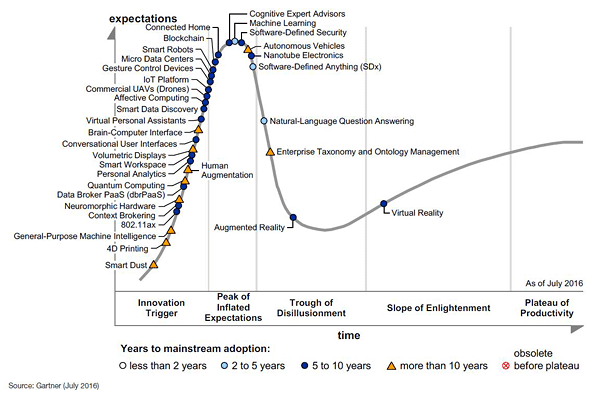At first there’s a trigger, then a wave of reaction flows through the masses. The strength of the reaction creates disillusionment and shakes confidence, then, slowly but surely, a sense of enlightenment brings about true, sustainable productivity.
It is, of course, the hype cycle. An almost tediously predictable chart of the peaks and troughs we insist on going through to define and bring new technology to market. The 2016 edition of Gartner's Hype Cycle for Emerging Technologies was released last month and it’s all looking quite “smart.”
Gartner’s Hype Cycle distills insights from more than 2,000 technologies into a succinct set of “must-know” emerging technologies. Our focus on smart buildings and cities raises certain questions and opportunities about specific technologies on the chart. However, three overarching trends embody this year’s Hype Cycle; transparently immersive experiences, the perceptual smart machine age, and the platform revolution.

Transparently immersive experiences will continue to become more human-centric to the point where it will introduce transparency between people, businesses and things. This relationship will become much more entwined as the evolution of technology becomes more adaptive, contextual and fluid within the workplace, at home, and interacting with businesses and other people.
This trend includes thought-provoking futuristic technologies such as Brain-Computer Interface, Nanotube Electronics and 4D printing. Augmented and virtual reality also features in the ‘trough of disillusionment’ and ‘slope of enlightenment’, with potentially fundamental implications for the long–term future of buildings and working society as a whole.
In the more near-term smart building space, Connected Home has moved from the innovation trigger stage last year to the peak of inflated expectations this year. Expect highly publicized success stories amidst a sea of failures, as big and small players in the market toil over the results of pilot projects.
Connected Home, one way or another, is expected to reach a broad market but the coming years will separate hype from reality to refine home systems for mass market entry. We can look forward to risky connected home strategies, both successful and not.
Smart machine technologies will be the most disruptive class of technologies over the next 10 years due to radical computational power, near-endless amounts of data, and unprecedented advances in deep neural networks that will allow organizations with smart machine technologies to harness data in order to adapt to new situations and solve problems that no one has encountered previously.
This trend encompasses a broad range of technology at varying stages of development. Most people are probably still formulating their opinion on Smart Dust and 802.11ax, for example. However, as Autonomous Vehicles and Natural-Language Question Answering begin their descent into disillusionment, they will reveal their biggest problems while simultaneously feeling closer than ever.
Smart machine technologies in the smart building space include virtual personal assistants, which are expected to transcend our mobile devices to become an integral part of our built environment. The smart workspace also makes an appearance as an innovation trigger, along with smart robots and commercial UAVs (drones). Continued proof-of-concept stories and media interest will drive these trends toward an uncertain future.
One obvious omission from this year’s hype cycle is ‘deep learning’. The evolution of machine learning and precursor to artificial intelligence, deep learning is undoubtedly one of the most hyped buzzwords in tech circles today.
Gartner included machine learning on the hype cycle for the first time last year despite its first “emergence” in 1959 and has actually moved it back slightly up to the peak of ‘the peak of inflated expectations’, suggesting another 2 to 5 years before mainstream adoption. Deep learning, and its smart building applications, are nowhere to be seen.

The platform revolution is transforming the concepts of how platforms are defined and used. The shift from technical infrastructure to ecosystem-enabling platforms is laying the foundations for entirely new business models that are forming the bridge between humans and technology. Within these dynamic ecosystems, organizations must proactively understand and redefine their strategy to create platform-based business models, and to exploit internal and external algorithms in order to generate value.
Technologies such as the Internet of Things, quantum computing and software-defined anything (SDx), are driving the platforms that will ultimately support our digital society. Blockchain technology, which has touted promising smart city applications, makes an appearance this year at the ‘the peak of inflated expectations’. However, associated cryptocurrency and cryptocurrency exchange were shown descending the ‘trough of disillusionment’ in last year’s chart, and have been omitted this year. This puzzling pattern shows the confusion surrounding the much-discussed technology.
“The practical applications of the blockchain will take time, as well as regulatory blessings and long-term industry adoption,” suggested a Morgan Stanley report. While Roger Oliphant, chief architect of ACI Worldwide, said, “Large global banks have done tests, POCs, but they haven’t gone farther yet. It’s a waiting pattern, a holding pattern for the maturity of the technology to catch up.”
We may draw conclusions to certain additions and omissions from the hype cycle, but hype in itself does not tell us anything concrete. Similarly, we do not need research to tell us that there is hype surrounding certain technologies. However, 2016’s Hype Cycle, much like other years, captures the imagination, even reinforces or discourages actions, regardless of its not-so-scientific nature.



